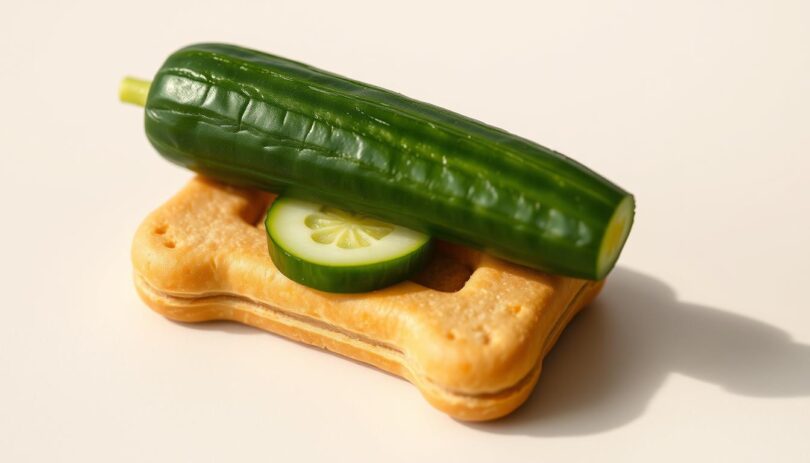Picture this: you’re slicing a crisp cucumber for a salad, and your furry companion gazes up with hopeful eyes. That moment of hesitation is familiar to many pet owners—wanting to share but prioritizing safety. Understanding what snacks align with a dog’s health needs is a responsibility every caring owner faces.
Cucumbers, known for their high water content and minimal calories, often spark curiosity. When prepared correctly, these crunchy vegetables can serve as a refreshing snack for most pets. Their mild flavor and satisfying texture make them appealing, especially during warmer months.
However, moderation and preparation matter. Always wash cucumbers thoroughly to remove pesticides, and slice them into bite-sized pieces to prevent choking. Introducing any new food requires gradual testing and professional guidance. For example, while cucumbers are generally safe, pickles (their brined counterpart) pose risks due to added salt and spices.
This article explores the benefits, potential concerns, and best practices for feeding cucumbers to pets. From nutritional value to serving tips, you’ll gain insights to make informed choices for your four-legged family member. Always consult a veterinarian to ensure dietary changes suit your pet’s unique needs.
The Nutritional Value of Cucumbers for Dogs
When exploring healthy treats, cucumbers stand out as a hydrating snack packed with nutrients. With 96% water content, they help replenish fluids while providing vitamins B, C, and K. Minerals like potassium and magnesium support muscle function and bone health, making them a smart choice for active pets.
Essential Vitamins and Minerals
Vitamin C boosts immunity, while vitamin K aids blood clotting. Potassium regulates heart rhythms, and magnesium promotes energy production. These nutrients work together to maintain your pet’s vitality without adding empty calories.
Low-Calorie Hydration Benefits
The high water content in cucumbers makes them ideal for hydration, especially during hot weather. Low-calorie snacks like cucumber slices help manage weight when substituted for richer treats. While commercial dog food meets core dietary needs, occasional veggie additions enhance variety.
Moderation remains key. Too many cucumber slices might reduce appetite for balanced meals. Always prioritize your pet’s primary food and consult a vet for personalized advice.
How to Safely Introduce Cucumbers to Your Dog
Adding fresh vegetables to your pet’s diet starts with proper preparation. Simple steps ensure treats remain safe and enjoyable while minimizing risks like digestive issues or obstructions.
Steps for Washing and Cutting
Begin by rinsing cucumbers under cool water to remove dirt and pesticides. Use a vegetable brush for thorough cleaning. For pets with sensitive stomachs, peel the skin to reduce fiber intake. Slice the vegetable lengthwise and scoop out seeds with a spoon. Cut into bite-sized pieces—smaller than a dime for toy breeds.
Observing Initial Reactions
Offer one or two pieces initially and monitor for 24 hours. Watch for signs like vomiting, diarrhea, or reluctance to eat regular food. If no issues arise, gradually increase portions. Avoid large slices, as they pose a choking hazard. Always supervise your pet during snack time.
Remember: treats should never replace balanced meals. Consult your veterinarian if unusual symptoms persist after introducing new foods.
Can Dogs Have Cucumber? Expert Feeding Guidelines
Veterinarians stress that even nutrient-rich snacks require thoughtful portioning. While crunchy vegetables make excellent low-calorie options, they should complement—not replace—a pet’s primary meals. Balancing treats with regular food ensures nutritional needs stay prioritized.
Determining Safe Serving Sizes
Experts recommend limiting treats to 10% of daily calories. For a 30-pound adult, this equals roughly 5-7 thin slices. Smaller breeds might handle 2-3 pieces, while larger dogs could enjoy up to 10. Adjust portions based on activity levels and existing diet plans.
Puppies need smaller amounts due to developing digestive systems. Introduce half a slice initially, gradually increasing to 1-2 pieces if tolerated. Always remove seeds and peel skins for easier digestion.
- Monitor energy levels and stool consistency after feeding
- Adjust quantities if weight fluctuations occur
- Consult a vet when mixing with other snacks or supplements
These guidelines provide a starting point. Individual responses vary, so observe your pet’s reactions closely. Pair sensible portions with regular exercise to maintain optimal health.
Portion Control: Determining the Right Cucumber Slices by Dog Size
Tailoring cucumber portions to your pet’s size ensures safe snacking. Smaller breeds need fewer slices to avoid overwhelming their digestive systems, while larger animals can handle more without excess calories. Striking this balance prevents stomach discomfort and maintains nutritional harmony with regular meals.
Guidelines by Weight Categories
Extra-small dogs (under 10 lbs), like Chihuahuas, thrive with 1-2 thin slices per day. Small breeds (10-25 lbs), such as Beagles, can enjoy 3-4 pieces. Medium-sized pets (25-50 lbs) benefit from 5-6 slices, while large dogs (50-90 lbs) handle 7-8. Extra-large breeds like Great Danes may safely consume 9-10 slices daily.
Chewing and Sizing Tips
Cut cucumber slices to match your pet’s jaw size—think dime-sized for Yorkies and quarter-sized for German Shepherds. Thinner slices (⅛ inch) reduce choking risks. Supervise enthusiastic chewers, as rapid swallowing may cause blockages. For pets with dental issues, mash pieces into their food for easier digestion.
Adjust portions if your companion receives other treats or shows sensitivity to high-fiber foods. Pair cucumber slices with protein-rich snacks to maintain balanced nutrition. Always introduce new quantities gradually and track energy levels between meals.
Recognizing Signs of Over-Feeding and Digestive Upsets
Even nutrient-rich snacks like cucumbers can cause issues if overfed. While cucumbers offer hydration, excessive amounts may overwhelm a pet’s stomach. Owners should watch for subtle changes in behavior or digestion that signal discomfort. Early detection helps prevent minor upsets from escalating.
Symptoms to Watch For
Common signs include vomiting, loose stools, or reluctance to eat. Lethargy or abdominal discomfort—like whining when touched—may also occur. Puppies and senior pets are more prone to stomach sensitivity due to weaker digestive systems. Blood in stool or repeated vomiting warrants immediate attention.
When to Consult Your Veterinarian
Mild symptoms often resolve within 24 hours with a bland diet and hydration. However, persistent diarrhea lasting over a day or signs of dehydration—dry gums, sunken eyes—require professional care. For puppies, rapid weight loss or refusal to eat merits a vet visit. Owners can explore safe solutions for diarrhea under veterinary guidance.
Moderation and observation are key. Adjust portions if stomach upset arises, and prioritize balanced meals. Always consult a vet when introducing new foods to at-risk pets.
Avoiding Common Pitfalls: Pickles, Pesticides, and Potential Allergens
While fresh cucumbers offer benefits, hidden risks lurk in prepared forms. Pickled varieties contain dangerous sodium levels and additives like garlic, which is toxic to pets. Even small amounts of brined vegetables may cause dehydration or kidney strain.
Non-organic cucumbers often carry pesticide residues. Always scrub skins thoroughly or peel them before serving. Opt for homegrown or certified organic vegetables when possible to minimize chemical exposure.
Some animals react to cucumber seeds or fibrous skins. Remove seeds for pets with sensitive stomachs, and slice skins into digestible pieces. Watch for itching, gas, or stool changes after introducing this food.
Check ingredient lists on store-bought veggie mixes. Many contain onions, spices, or preservatives unsafe for your companion. Plain, fresh cucumbers remain the safest choice—skip dressings, dips, or seasoning blends.
By prioritizing simple preparations and vigilance, you turn this crunchy snack into a reliable treat. When in doubt, consult your veterinarian about your pet’s unique dietary needs.
Creative Ways to Serve Cucumber as a Dog Treat
Transform ordinary cucumbers into exciting snacks with simple yet innovative ideas. Beyond basic slices, these cooling vegetables adapt well to recipes that combine nutrition with engagement. Thoughtful preparation turns everyday ingredients into enjoyable rewards that align with your companion’s health needs.
Frozen Cucumber Treats
Freeze thin slices for a crunchy summer snack. For longer-lasting enjoyment, blend peeled cucumbers with plain yogurt and pour into ice cube trays. Stuff the mixture into a KONG toy before freezing to create mental stimulation during hot afternoons.
Mixing Cucumbers with Other Dog-Safe Fruits
Combine diced cucumbers with watermelon chunks or mashed banana for a hydrating blend. Puree the mixture and freeze in silicone molds for bite-sized rewards. Always remove seeds from fruits and avoid grapes, raisins, or citrus.
Experiment with textures by dehydrating cucumber slices at low heat for portable chews. Monitor portion sizes and introduce new recipes gradually. Pair creativity with safety by consulting your veterinarian about ingredient compatibility and serving frequencies.
Understanding the Role of Cucumber in a Balanced Dog Diet
Maintaining nutritional balance requires careful consideration of every snack. While crunchy vegetables add variety, they should never overshadow complete meals designed for pets. A well-planned diet prioritizes proteins and fats while using treats like cucumber slices to enhance hydration and nutrient intake.
Integrating Treats with Regular Meals
Small amounts of cucumber work best when paired with existing feeding routines. Mix a few thin slices into kibble or use them as rewards during training sessions. This approach maintains calorie control while introducing beneficial vitamins like C and K.
Treats should never exceed 10% of daily food intake. For puppies, start with a single piece to test tolerance. Gradually increase portions if stools remain firm and energy levels stay consistent. Always prioritize high-quality commercial food as the dietary foundation.
The high water content in cucumbers supports hydration without adding empty calories. Their mild flavor makes them ideal for pets hesitant to try new foods. Pair these snacks with lean proteins to create balanced, satisfying meals.
Transitioning to any addition requires patience. Introduce one vegetable at a time over 3-5 days. Monitor for changes in digestion or appetite. Consult your veterinarian to ensure dietary adjustments align with your companion’s health needs.
Modern Trends: Cucumber Water and Innovative Feeding Ideas
Pet wellness trends are evolving, with cucumber-infused recipes leading the way. These fresh approaches combine hydration support with natural nutrients, aligning with pet owners’ growing interest in functional treats. Simple to prepare and rich in benefits, cucumber-based options offer modern solutions for health-conscious households.
Health Benefits of Cucumber Water
Infusing water with cucumber slices boosts hydration while delivering potassium and vitamin K. The mild flavor encourages pets to drink more, especially during summer. This natural electrolyte source helps maintain energy levels without added sugars or artificial ingredients.
DIY Cucumber Infusions for Pets
Create pet-safe cucumber water by soaking thin slices in filtered water for 2-4 hours. Remove seeds and skins for sensitive stomachs. Freeze the infusion into ice cubes for a cooling summer snack. Always avoid adding citrus, sweeteners, or herbs.
These methods align with holistic pet care movements emphasizing whole-food nutrition. Pair cucumber water with regular meals to enhance hydration and nutrient intake. Monitor your companion’s response and adjust recipes based on their preferences.
Final Thoughts on Feeding Cucumbers to Your Dog
Offering crunchy vegetables as snacks requires balancing safety with nutritional value. Fresh cucumber slices, when washed and peeled to remove pesticide residue, provide a hydrating, low-sugar option for most pets. Their mild flavor and crisp texture make them ideal for training rewards or summer treats.
Rich in vitamins and minerals, this vegetable supports hydration without spiking blood sugar levels. Always introduce new foods gradually, starting with one or two small pieces. Observe your pup for digestive changes like loose stools or reduced appetite.
Portion control remains critical—adjust serving sizes based on your companion’s weight and activity level. Pair these snacks with protein-rich foods to maintain balanced nutrition. Avoid seasoning or pickled varieties, which often contain harmful additives.
When prepared thoughtfully, cucumbers add variety to your pet’s diet while promoting hydration. Consult your veterinarian to confirm this treat aligns with their health needs. With proper care, these crunchy bites become a refreshing staple your furry friend will eagerly anticipate.
FAQ
Are cucumbers safe for dogs to eat?
Yes, plain cucumber slices are generally safe for pets. They’re low in calories and lack harmful ingredients like garlic or excess salt. Always remove seeds and cut them into bite-sized pieces to prevent choking hazards.
What nutrients do cucumbers provide for pets?
Cucumbers contain vitamins K and C, potassium, and magnesium. Their high water content (over 96%) supports hydration, making them a refreshing snack during warm weather or after exercise.
How should cucumbers be prepared for dogs?
Wash thoroughly to remove pesticides, peel if desired, and slice into small, manageable pieces. Avoid seasoning or pickling, as additives like vinegar or onion powder can upset a pet’s stomach.
Can puppies eat cucumber treats?
Puppies can try small amounts once they’re weaned. Monitor closely for reactions like diarrhea or vomiting, and consult a veterinarian before introducing new foods to young animals.










Leave a Comment